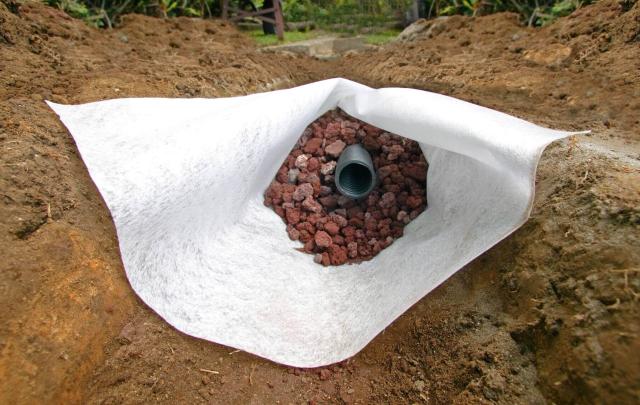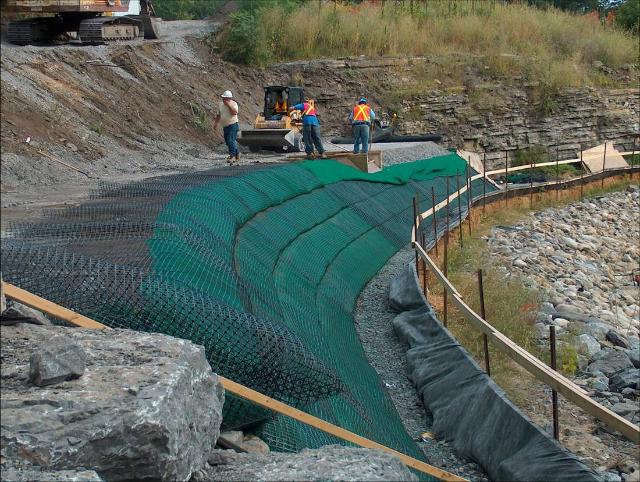Material
Geosynthetics
Nov 2 2022
Geosynthetics refers to a synthetic product that made from a polymeric material that helps in most civil engineering purposes. The polymers that manufacture the geosynthetic product are mainly polyethylene(PE), polypropylene(PP), polyvinyl chloride(PVC), polystyrene(PS), polyethylene terephthalate(PET), polyamide Nylon(PA).
Introduction
In overall, geosynthetics usually provide the important functions of separation, drainage, moisture barrier, reinforcement, and filtration. The installation is usually placed inside the soil, surface or as a separation layer of different soil which eventually strengthening or protecting the soil from erosion. The application of geosynthetic is usually found on transportation, environmental, marine, geotechnical and other infrastructure such as bridge, railroad, waste landfill, revetments, canals, etc. Geosynthetics contain many products with different function so in general, these synthetic products are separated into geotextiles, geogrids, geonets, geomembranes, geocomposites, and others.Applications
Geotextiles is one of the largest produce geosynthetics. They are indeed produced as the traditional way of textiles but the difference is that the material is synthetic fiber rather than silk, cotton, flax, ramie or wool. The production method results on geotextile porous to water flow and enables it to provide the major function of strengthening and protecting the soil by draining the water in it without mixing or losing the soil. Geotextiles are usually lightweight, easy to work with, high tensile strength, corrosion resistance and mildew resistant. However, normal geotextiles usually have a low UV resistance so a direct UV radiation will easily be aging the product. Often adding coating or avoid direct sunlight exposure will preserve its durability and wear resistant. Geotextile is commonly produced in sheet form(packaged in roll form) and after it produces it can be made into other useful product such as geotextile sandbag. Another growing usage of geosynthetics is the geogrids. Geogrid is a geosynthetic material that used for reinforcement and separation. Unlike geotextile, the geogrids layout contain big gaps between each individual ribs and form a grid-like configuration. The gaps are usually referred to as apertures and the size would vary for different usages or application. The geogrids application can often be found on walls, steep slopes, foundation soils, etc. Currently, they are three common way of forming geogrids, one is stretched in one or two directions, weaving & knitting machinery and lastly the welding or strap together.
Another popular geosynthetics is the geomembrane. Geomembrane functions are very different from the geotextiles as geomembrane has a very low permeability to act as a barrier to prevent fluid flow through or become a liquid container. Somehow geomembrane can also be made from the production of geotextiles with asphalt, elastomeric or other polymer sprays. Same like geotextiles, geomembrane is produced in thin sheet form and packaged to roll form. Geomembranes are usually effective than normal concrete, asphalt or compacted clay on, ponds, canals, roads, and reservoir as geomembrane are less susceptible to ground movement, safer, more economical and environmentally friendly.
Contact us today for your geosynthetics supplier or contractor in Malaysia.
Another popular geosynthetics is the geomembrane. Geomembrane functions are very different from the geotextiles as geomembrane has a very low permeability to act as a barrier to prevent fluid flow through or become a liquid container. Somehow geomembrane can also be made from the production of geotextiles with asphalt, elastomeric or other polymer sprays. Same like geotextiles, geomembrane is produced in thin sheet form and packaged to roll form. Geomembranes are usually effective than normal concrete, asphalt or compacted clay on, ponds, canals, roads, and reservoir as geomembrane are less susceptible to ground movement, safer, more economical and environmentally friendly.
Advantages
Geosynthetics usually has the following advantage:Lightweight
High Flexibility
Economical
Chemical resistance
Corrosion Resistance
Erosion Control
Popular Geosynthetics
Geotextile
Geomembrane
Geogrids
Geonets
Geocomposites
Geofoam
Geocells
Contact us today for your geosynthetics supplier or contractor in Malaysia.


